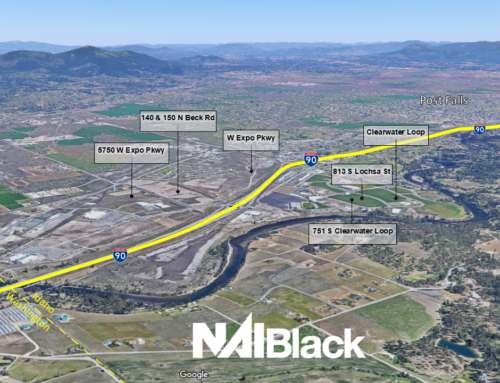BY STEVE LEWIS
SPONSORED BY SIOR FOUNDATION
For quite a while now, CRE observers have been touting the significant growth potential for secondary and tertiary markets. Those commentaries are now being supported even more strongly by the realities on the ground, as evidenced by the experience of SIORs in those markets. In this review of a number of different markets, SIORs say that the lower density, lower costs, and local attractions—and in some cases insulation from wild market swings—all speak to this growth being not just a fad, but a potentially long-term trend.
“There has been an increased interest in our tertiary market from companies and investors that are currently located in the New York metro market during the past four months,” reports Amy Hawley, SIOR, associate broker, SVN | Imperial Realty, Allentown, Penn. “Our region offers good highway access to the larger population centers, without some of the problems associated with densely populated areas. And the operating expenses are lower.”
“I would say that I’m in a tertiary market (Charleston, S.C.),” adds Michael White, SIOR, broker-in-charge, Charleston Industrial, LLC, “but we’re clearly benefitting because we’re well known as a vacation-golf-wedding destination for people from the northeast. We’ve seen a real increase in people wanting to leave dense urban areas and investigate team offices, smaller footprints, and more of a life-work balance that as a smaller market, we can provide.”
“We’re definitely getting sentiment from some level of investors and people living in bigger cities who want to get into smaller markets,” notes Dan Drotos, SIOR, senior director, Colliers International, Gainesville, Fla., which he describes as “definitely tertiary.” Geoff Poston, SIOR, vice president Industrial Group, Cushman & Wakefield | Thalhimer, in Hampton Roads, Va., says that “In the Norfolk/Virginia Beach market over the past 12 to 18 months, we’ve seen greater interest from national industrial developers and investors.”
In Spokane, Wash., Christopher Bell, SIOR, managing broker, Black Commercial, Inc., notes that “We have always seen strong in-migration from Seattle and Portland, but we are getting more and more inquiries and deals completed with tenants and buyers from California, Arizona, Texas, and now more East Coast states. We are seeing the majority of businesses move to Spokane for quality of life. The joke in Spokane is you are never further than 20 minutes from anything, and people in major metro markets are tired of one- and two-hour commutes to and from work.”
BEHIND THE CHANGE
While commonalities among these markets are noted as the basis of the growth trend, they all have their own distinct characteristics and additional factors that draw investors, developers, and business owners.
“Interest is driven by shifting supply chain strategies, due in large part to rising costs in the Northeast and the eCommerce user’s ‘hyperlocal’ focus,” notes Poston. “The Mid-Atlantic region in general is getting more looks at multistate, big box requirements.”
Having remained “under the radar” during the industrial run-up over the past several years, he adds, there are still good sites and value opportunities in the area that national players are beginning to recognize. “According to CoStar analytics, our vacancy rate sits at 2.1% over 103 million square feet of inventory and no spec construction underway, although there are some rumblings that spec development is finally coming considering the vacancy rate and recent rise in asking rents,” says Poston.
“There is renewed interest from manufacturers and investors in some of our industrial listings that are less than 100,000 square feet,” says Hawley. “Residential realtors also report an increase in the amount of families that want to escape the large cities and relocate to our region; employers may be aware of this trend. Prospects have requested video tours ahead of their travel plans to inspect various listings.”
In Spokane, Bell says the existing supply of available industrial space has contracted to just a 2.5% market vacancy, and average rents get up to the level that they “are seeing an unprecedented amount of speculative building and new construction.” He says he is currently marketing a project to construct a 1.5 million square foot industrial park, “Which is a big deal in an industrial market with 29 million square feet of existing total building area.”
ADJUSTING TO THE MARKET SHIFT
In some cases, say SIORs, the increased demand in their market has caused them to shift strategies or employ new tactics.
“I’m trying to refine our marketing message to appeal to that specific clientele and feature the benefits of being in a smaller market,” says White. These include the fact that remote working enables companies to locate in geographically dispersed areas; greater flexibility due to reduced commute times; and a better lifestyle for similar salaries.
“I landed a software company that took about 20,000 feet with us, and they had the opportunity to be in a larger northeast market, but chose to be here,” he shares. “Their headquarters and some founders are still in the Philadelphia area, but they realized they can attract a broader pool of talent by having more geographic dispersity.”
The Cushman & Wakefield | Thalhimer industrial team has been working closely with several national industrial developers and investors as they enter the market, says Poston. “We’ve got some challenges that would appear to be non-starters to most, but once we help our clients dig into the fundamentals and have a better understanding for our market, folks are finding there are opportunities.”
He notes that in the Virginia Beach area, they are challenged geographically, surrounded by bodies of water on three sides (Atlantic Ocean, Chesapeake Bay, and James River), with plenty of wetlands, poor soils, and the Great Dismal Swamp. “Core, infill locations are essentially fully developed with older product and limited functionality,” he says. “Finding the new development, redevelopment, or value-add investment opportunities in infill locations is possible, but it requires aggressiveness and creativity.”
“We have begun using drone photography for some of our listings,” adds Hawley. “We will be using an interior 360 tour format so that prospects can evaluate their options and then have a short list of properties that they still want to consider when they do come to our region.”
MEETING THE CHALLENGES
Of course, with change—even positive change—comes challenges, and the growing attractiveness of secondary and tertiary markets is no exception. “Adaptability of the floor plans within our listings has become a priority,” says Hawley. “I have been working with space planning architects to evaluate which listings have the most adaptable floor plans.”
“The biggest challenge in attracting people from large northeastern cities is their reluctance to relocate away from their traditional customer base,” adds White. “We say that working remotely has changed the face-to-face factor.”
Of course, he continues, working with relocating customers always involves a learning curve. “They have to learn to adapt to a different pace of life,” he notes. “We try to work with them in follow-on. In a small market, a service provider like myself has to be adaptive, establish trust quickly, [as well as] be able to identify clients’ needs and how they can be applied in smaller markets.”
Poston says that one of the biggest challenges to being in a tertiary market is deal velocity and income generation. “There are approximately 25 ‘true’ industrial brokers in our market, and only so many deals to go around,” he explains. “All you can do is strive to be an expert and do the best job for the clients you retain.”
He adds, however, that “As trusted real estate advisors in tertiary markets, we can, and should, offer the same level of service and expert advice as our SIOR counterparts in major or secondary markets.”
PANDEMIC CLOUDS THE FUTURE
Of course, COVID-19 clouds the future for all of us. While SIORs believe the long-term future for secondary and tertiary markets is strong, at present it is certainly impacting their efforts.
“Prospects are still trying to grapple with the total effect that the pandemic will have upon their workplaces, employees, and demand for their manufactured products,” says Hawley. “Decision timelines are taking longer. Property owners are slow to accept the changing landscape in the economy and how it has affected their perceived value of their property.”
Drotos points to the attraction of both health care facilities and, of course, the University of Florida, in Gainesville. “Businesses say that having these economic drivers keep our market insulated,” Drotos shares. “Up until COVID-19 that was the truth.”
One of the saving graces for his firm, he says, is that they are generalists. “Peers in bigger markets get really specialized,” he observes. “Being in a small market we are diversified by necessity, so we’re able to pivot, and still move along. Hopefully, once we get stabilized, we will go back to operating where we were, with good quality economic drivers.”
“I think it’s a long-term change,” White asserts. “This lesson [of success in working remotely] will have a lasting impact on a number of generations.”
“There is always going to be change in the marketplace that affects the value of a given property,” adds Hawley. “Changes seem to be at a more rapid pace. Macro trends and changes are more apt to have a ripple effect upon the overall value and utility of commercial-industrial real estate. Sharing ideas and data with our peers enables us to stay on top of important trends.”
Poston also sees the growth of secondary and tertiary markets as part of a long-term change. “With the consumer shift to e-commerce, accelerated greatly by the COVID-19 pandemic, and now supply chain diversification and risk mitigation also influenced by the COVID-19 pandemic, I expect industrial to thrive here for years to come,” he says. “It’s an exciting time to be an industrial broker!”
CONTRIBUTING SIORS
Geoff Poston, SIOR
Amy Hawley, SIOR
Michael White, SIOR
Christopher Bell, SIOR
Dan Drotos, SIOR
This article was featured in Q3 2020 SIOR Report Magazine






